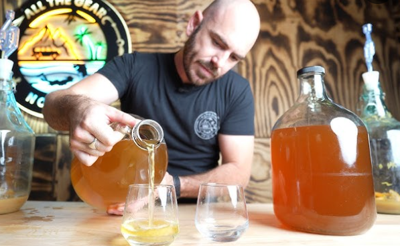
Homebrewing mead is a fun and creative way to explore the world of fermentation. At the heart of this is honey selection, which plays a major role in shaping the flavor, fragrance, and final personality of the product. In this post, we will take a closer look at the different honey types and how they may be suitable for your next mead-making experience.
Understanding Mead and Honey
Mead, sometimes referred to as honey wine, has been enjoyed for thousands of years. It mostly consists of honey, water, and yeast. However, more so than other additives, honey can significantly alter the flavor, so be aware of what each variety contributes to the brew. Therefore, it is vital to use only the best honey for mead.
Honey types vary depending on the fields from which the bees have gathered nectar. These variations lead to different flavors and shades of color, which affect the mead. Selecting the right honey is really important for achieving the flavor profile you want.
What Types of Honey are Used for Brewing Mead?
There are a multitude of honey types sought by the mead maker, a few of which include the following:
Wildflower Honey
Wildflower honey, also known as blossom honey, is made from the pollen of various types of flowers; hence, it has a complex and diverse flavor. It has the potential to create a nuanced mead that is often floral and fruity. This is a well-rounded option for both traditional meads and flavored meads.
Clover Honey
Clover honey has a subtle and mild taste. This type of honey tends to top the pop charts for beginners. Its mild sweetness easily lends itself to blending with various ingredients, such as fruits or spices. This is a good beginner's honey for someone to work from, making a rounded and easy-to-drink mead.
Orange Blossom Honey
Depending on the orange grove it comes from, orange blossom honey has a more floral and citrusy fragrance. It gives mead a crisp, refreshing quality, ideal for summer drinks. It is best suited for those looking for a bright, herbal-infused beverage.
Buckwheat Honey
Buckwheat honey is rich and full-bodied, with a malty taste. It can make a rich mead with depth. But also seems to attract those who like a bold, funky, hearty beverage. This type of honey is suitable for meads intended to be aged and mature.
Acacia Honey
Acacia honey types are known for their pale color and mild sweetness. You get a clear, smooth mead with delicate floral tones. This is a great option for anyone who prefers a more sophisticated and stylish beverage.
Best Honey Factors to Consider
When choosing honey for making mead, there are a few things you need to take into account. Here are the top ten factors to consider when choosing honey.
Flavor: The honey variety must reflect the flavor of the mead. Some prefer a light and smooth texture, while others opt for a more robust flavor.
Honey color and clarity can affect how the finished mead looks. Light honeys will provide a clearer mead, although darker varieties may give your mead a darker color.
Vanilla and Price: Local availability and budget may also play a role in choosing honey. Particularly rare species may be expensive, but readily available types tend to be less costly.
Experimenting With Blends
If you are curious about the grape juices, blending honeys can also produce a complex and intriguing mead experience. Pair some types of clover and buckwheat or wildflower and orange blossom, and you may be surprised by the results. There is plenty of room for exploration of your own in mead-making.
Tips for Successful Mead Making
Quality Ingredients: Never skimp on the honey and use fresh ingredients. The honey must be pure, which will then either enhance or transform the flavor or aroma of the mead.
Time and Attention: Mead brewing requires time. Give the mead enough time to age, which is necessary to achieve its full flavor potential. However, hastening the process will yield an unsatisfactory output.
Choosing honey for making mead is a deeply personal and creative process, and it depends on the taste and character you are after in the finished product. Having a working understanding of the characteristics of the different honeys available and the kind of product you want to end up with enables homebrewers to create delicious meads that capture their individuality. In conclusion, whether you decide to build your approach traditionally or experiment, the path towards the mead will always be full of possible experiences.


(0) comments
We welcome your comments
Log In
Post a comment as Guest
Keep it Clean. Please avoid obscene, vulgar, lewd, racist or sexually-oriented language.
PLEASE TURN OFF YOUR CAPS LOCK.
Don't Threaten. Threats of harming another person will not be tolerated.
Be Truthful. Don't knowingly lie about anyone or anything.
Be Nice. No racism, sexism or any sort of -ism that is degrading to another person.
Be Proactive. Use the 'Report' link on each comment to let us know of abusive posts.
Share with Us. We'd love to hear eyewitness accounts, the history behind an article.